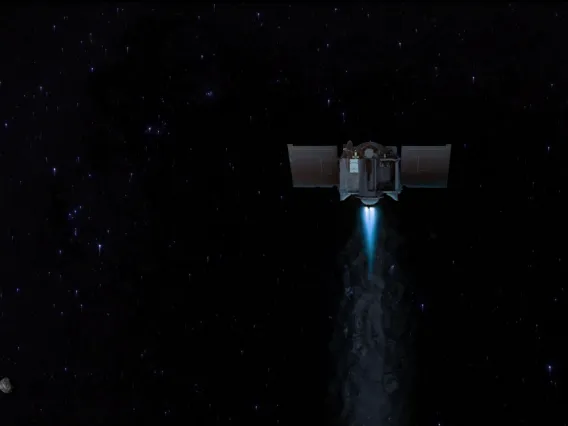
UArizona-Led OSIRIS-REx Mission Plans for May Asteroid Departure
Since its launch in September 2016, the OSIRIS-REx spacecraft has traveled billions of miles, mapped the surface of an asteroid in unprecedented detail, and made new scientific discoveries about near-Earth asteroids. Now, it's preparing to bring a piece of asteroid Bennu home.
UArizona-Led OSIRIS-REx Mission Plans for May Asteroid Departure
×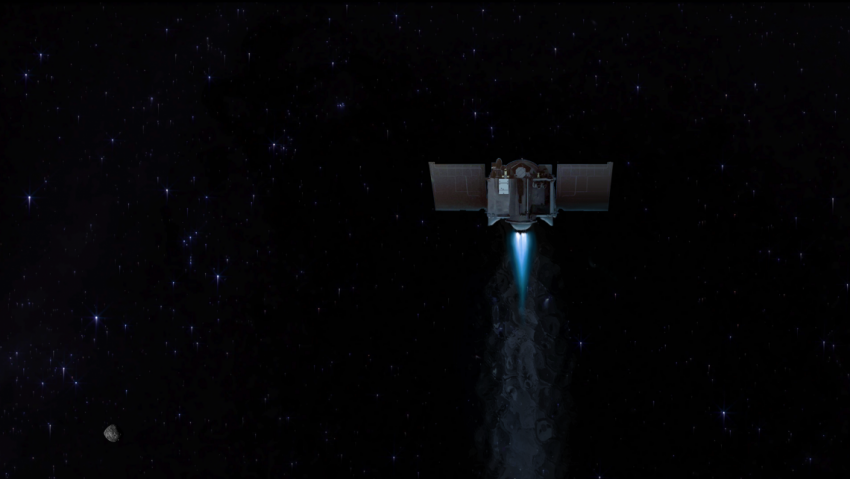
University Communications and Goddard Space Flight Center - January 26, 2021
On May 10, NASA's OSIRIS-REx spacecraft will say farewell to asteroid Bennu and begin its two-year journey back to Earth, where the dust and rocks collected during the Touch-And-Go maneuver in October will be studied by scientists, including OSIRIS-REx mission principal investigator and University of Arizona planetary scientist Dante Lauretta.
During its Oct. 20, 2020, sample collection event, the spacecraft collected a substantial amount of material from Bennu's surface, likely exceeding the mission's requirement of 2 ounces, or 60 grams. The spacecraft is scheduled to deliver the sample to Earth on Sep. 24, 2023 in the Utah desert.
The May departure date allows the spacecraft to consume the least amount of fuel and also provides the OSIRIS-REx team with the opportunity to plan a final spacecraft flyby of Bennu. This activity was not on the original mission schedule, but the team is studying the feasibility of a final observation run of the asteroid. They want to learn how the spacecraft's contact with Bennu's surface altered the sample site.
If feasible, the flyby will take place in early April and will observe sample site Nightingale from a distance of approximately 2 miles. Bennu's surface was considerably disturbed after the Touch-and-Go, or TAG, sample collection event, with the collector head sinking 1.6 feet into the asteroid's surface. The spacecraft's thrusters also disturbed a substantial amount of surface material during the back-away burn.
The mission is planning a single flyby, mimicking one of the observation sequences conducted during the mission's Detailed Survey phase in 2019. OSIRIS-REx would image Bennu for a full rotation to obtain high-resolution images of the asteroid's northern and southern hemispheres and equatorial region. The team would then be able to compare these new images with the previous high-resolution imagery of Bennu obtained during 2019 to inspect how the sample site was altered as a result of the sample collection event.
These post-TAG observations would also give the team a chance to assess the current functionality of science instruments onboard the spacecraft – specifically the OSIRIS-REx Camera Suite, OSIRIS-REx Thermal Emission Spectrometer, OSIRIS-REx Visible and Infrared Spectrometer and OSIRIS-REx Laser Altimeter. It's possible that the instruments were coated by dust during the sample collection event, and the mission team wants to evaluate the status of each. Understanding the health of the instruments is also part of the team's assessment of possible extended mission opportunities after the sample is delivered to Earth.
The spacecraft will remain in asteroid Bennu's vicinity until May 10, when the mission will enter its Earth Return Cruise phase. Upon arrival to Earth, OSIRIS-REx will jettison the Sample Return Capsule. The capsule will then travel through the Earth's atmosphere and land under parachutes at the Utah Test and Training Range.
Upon recovery, the capsule will be transported to the curation facility at NASA's Johnson Space Flight Center in Houston. The sample will be distributed to laboratories worldwide, including the University of Arizona, allowing scientists to study the formation of the solar system and Earth as a habitable planet.
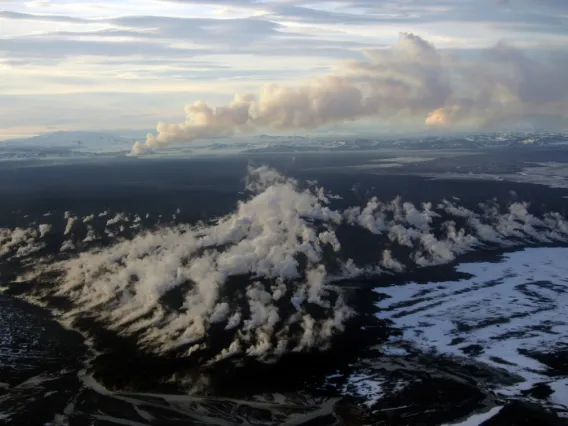
With $3M NASA Grant, UArizona Scientists Will Test Mars Exploration Drones in Iceland
NASA has awarded $3.1 million to Christopher Hamilton in UArizona's Lunar and Planetary Laboratory to develop a drone that could act as a "field assistant" to a rover and explore previously inaccessible regions on Mars.
With $3M NASA Grant, UArizona Scientists Will Test Mars Exploration Drones in Iceland
×
By Daniel Stolte, University Communications - January 13, 2021
A team of scientists led by Christopher Hamilton of the University of Arizona is gearing up to send drones on exploration missions across a vast lava field in Iceland to test a next-generation Mars exploration concept.
Hamilton is the principal investigator on a project that has been awarded a $3.1 million NASA grant to develop a new concept combining rovers and unmanned aerial systems, commonly known as drones, to explore regions of the red planet that have been previously inaccessible. These new Rover–Aerial Vehicle Exploration Networks will be tested in Iceland to explore volcanic terrains similar to those observed on Mars.
NASA selected the RAVEN project as one of only four proposals out of 48 proposals competing for funding from NASA's Planetary Science and Technology Through Analog Research program.
RAVEN adds an entirely new approach to NASA's paradigm of planetary exploration, which traditionally has centered around four steps, each building on the scientific findings of the previous one: flyby, orbit, land and rove, according to Hamilton, an associate professor in the UArizona Lunar and Planetary Laboratory who oversees a team of 20 scientists and engineers involved in the RAVEN project.
The first spacecraft sent to a previously unvisited body in the solar system commonly executes a flyby pass to collect as many data as possible to inform subsequent robotic missions, which consist of another space probe placed into orbit, then a lander, which studies the surface in one place, and, finally, a rover built to move around to visit and analyze various points of scientific interest.
"With RAVEN, we're adding 'fly' to that list," Hamilton said. "And not only that – the whole concept is really geared towards building new technology and procedures for two robots to work together on an extraterrestrial body. We are going to look at how a rover and a drone can work together to maximize the scientific output of such a mission."
When the RAVEN team members looked for suitable proving grounds that would provide a realistic backdrop for their work, they found it in a vast lava field in the highlands of Iceland. This pristine area is otherworldly enough that NASA used it in preparing the Apollo astronauts for walking on the moon. After extensive exploration, the team homed in on the Holuhraun lava flow field, created by an eruption only five years ago.
"It's some of the newest real estate in the world," Hamilton said about the barren landscape, which is devoid of vegetation or topsoil. "What makes it especially interesting to us is that the lava was emplaced in a sandy area, which is very similar to what some Martian terrains look like."
Analog landscapes, such as Holuhraun, are invaluable to planetary scientists because they provide the next best thing to an alien world right here on Earth. Often shaped by similar geologic processes as their extraterrestrial counterparts, they serve as realistic mock environments to prepare explorers – both human and robotic – to safely navigate the real thing. A major challenge in exploring young volcanic terrains on Mars is that the surfaces are too rough for a rover to traverse. RAVEN will open new opportunities for exploration by enabling a rover and drone to work together. The drone will provide reconnaissance to scout the best path forward, and even be able to collect and return remote samples that are inaccessible to the rover.
"Volcanic terrains offer exciting targets for exploration because of their potential to generate habitable hydrothermal systems, which could support or preserve microbial life," Hamilton said. "RAVEN would make such locations accessible for the first time."
RAVEN builds upon recent developments in drone technology – such as the Mars Helicopter, accompanying NASA's Mars 2020 rover, which launched last July, and the DragonFly mission to Saturn's moon Titan.
RAVEN will provide a test platform for innovative technologies like remote sample acquisition and navigation based on computer-generated, 3D terrain models. Insights gathered during the three-year duration of the RAVEN project will directly inform next-generation follow-up missions to NASA's upcoming Mars 2020 mission, which will include a lightweight, twin-rotor drone named Ingenuity that will be used as a technology demonstration to test powered flight on Mars for the first time.
"Once Mars Helicopter demonstrates the ability to fly on Mars, we would design the next-generation system capabilities," Hamilton said. "Specifically, we'd be looking at what you would do with the next-generation architecture."
A centerpiece of the project is the RAVEN Claw, a prototype grabbing device attached to a drone that can be configured in various ways, for example to pick up rocks or scoop up sand, and to return cached samples to the rover. Also tested will be alternative payload configurations, including lidar, hyperspectral imaging and drilling technology.
Lidar, which is a method for measuring distances using laser light, is what allowed the UArizona-led OSIRIS-REx sample return mission to maneuver a spacecraft into the closest orbit ever accomplished around a solar system body.
A hyperspectral imaging camera enables RAVEN to see light of many wavelengths, promising greater scientific return from local operations by improving the scouting that directs the rover to the target location.
"It is a testament to the University of Arizona's long-standing track record in planetary exploration that NASA continues to trust our experts with finding solutions to some of our biggest challenges," said University of Arizona President Robert C. Robbins. "RAVEN is no exception, as this project is part of the bold vision to land humans on Mars in the not-too-distant future. I am excited to see where this project will lead."
The RAVEN project brings together institutions in three nations: the University of Arizona, the California Institute of Technology/Jet Propulsion Laboratory, Honeybee Robotics, the University of Tennessee and United States Geological Survey in the U.S.; the University of Western Ontario, the Canadian Space Agency and MacDonald, Dettwiler and Associates Ltd. in Canada; and the University of Iceland and Vatnajökull National Park Service in Iceland.
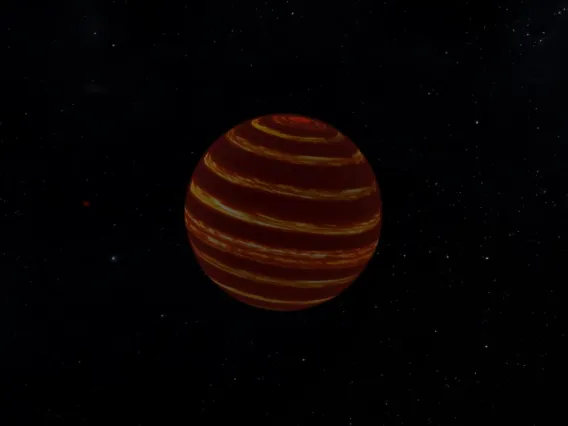
Striped or Spotted? Winds and Jet Streams Found on the Closest Brown Dwarf
Planetary scientists wondered if bands of winds or swirling storms dominated the atmospheres of brown dwarfs. UArizona-led research has solved the mystery.
Striped or Spotted? Winds and Jet Streams Found on the Closest Brown Dwarf
×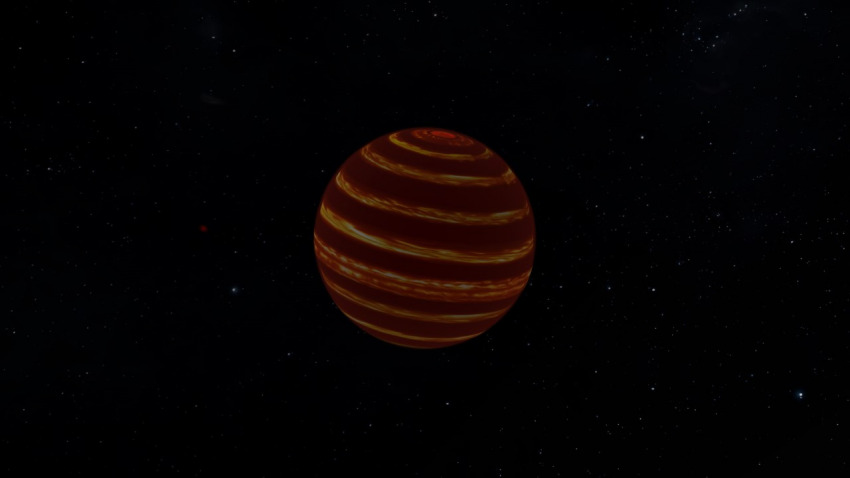
By Mikayla Mace Kelley, University Communications - January 7, 2021
A University of Arizona-led research team has found bands and stripes on the brown dwarf closest to Earth, hinting at the processes churning the brown dwarf's atmosphere from within.
Brown dwarfs are mysterious celestial objects that are not quite stars and not quite planets. They are about the size of Jupiter but typically dozens of times more massive. Still, they are less massive than the smallest stars, so their cores do not have enough pressure to fuse atoms the way stars do. They are hot when they form and gradually cool, glowing faintly and dimming slowly throughout their lives, making them hard to find. No telescope can clearly see the atmospheres of these objects.
"We wondered, do brown dwarfs look like Jupiter, with its regular belts and bands shaped by large, parallel, longitudinal jets, or will they be dominated by an ever-changing pattern of gigantic storms known as vortices like those found on Jupiter's poles?" said UArizona researcher Daniel Apai, an associate professor in the Department of Astronomy and Steward Observatory and the Lunar and Planetary Laboratory.
Apai is lead author of a new study published today in The Astrophysical Journal that seeks to answer that question using a novel technique.
He and his team found that brown dwarfs look strikingly similar to Jupiter. The patterns in the atmospheres reveal high-speed winds running parallel to to the brown drawfs' equators. These winds are mixing the atmospheres, redistributing heat that emerges from the brown dwarfs' hot interiors. Also, like Jupiter, vortices dominate the polar regions.
Some atmospheric models predicted this atmospheric pattern, Apai said, including models by the late Adam Showman, a UArizona Lunar and Planetary Laboratory professor and a leader in brown dwarf atmosphere models.
"Wind patterns and large-scale atmospheric circulation often have profound effects on planetary atmospheres, from Earth's climate to Jupiter's appearance, and now we know that such large-scale atmospheric jets also shape brown dwarf atmospheres," said Apai, whose co-authors on the paper include the Astronomical Observatory of Padua's Luigi Bedin and Domenico Nardiello, who is also affiliated with Laboratoire d'Astrophysique de Marseille in France.
"Knowing how the winds blow and redistribute heat in one of the best-studied and closest brown dwarfs helps us to understand the climates, temperature extremes and evolution of brown dwarfs in general," Apai said.
Apai's group at UArizona is a world leader in mapping the atmospheres of brown dwarfs and planets outside of our solar system using space telescopes and a new method.
The team used NASA's Transiting Exoplanet Survey Satellite, or TESS, space telescope to study the two brown dwarfs closest to Earth. At only 6 1/2 light-years away, the brown dwarfs are called Luhman 16 A and B. While both are about the same size as Jupiter, they are both more dense and therefore contain more mass. Luhman 16 A is about 34 times more massive than Jupiter, and Luhman 16 B – which was the main subject of Apai's study – is about 28 times more massive than Jupiter and about 1,500 degrees Fahrenheit hotter.
"The TESS space telescope, although designed to hunt for extrasolar planets, also provided this incredibly rich and exciting dataset on the closest brown dwarf to us," Apai said. "With advanced algorithms developed by members of our team, we were able to obtain very precise measurements of the brightness changes as the two brown dwarfs rotated. The brown dwarfs get brighter whenever brighter atmospheric regions turn into the visible hemisphere and darker when these rotate out of view."
Since the space telescope provides extremely precise measurements and it is not interrupted by daylight, the team collected more rotations than ever before, providing the most detailed view of a brown dwarf's atmospheric circulation.
"No telescope is large enough to provide detailed images of planets or brown dwarfs," Apai said. "But by measuring how the brightness of these rotating objects changes over time, it is possible to create crude maps of their atmospheres – a technique that, in the future, could also be used to map Earthlike planets in other solar systems that might otherwise be hard to see."
The researchers' results show that there is a lot of similarity between the atmospheric circulation of solar system planets and brown dwarfs. As a result, brown dwarfs can serve as more massive analogs of giant planets existing outside of our solar system in future studies.
"Our study provides a template for future studies of similar objects on how to explore – and even map – the atmospheres of brown dwarfs and giant extrasolar planets without the need for telescopes powerful enough to resolve them visually," Apai said.
Apai's team hopes to further explore the clouds, storm systems and circulation zones present in brown dwarfs and extrasolar planets to deepen our understanding of atmospheres beyond the solar system.
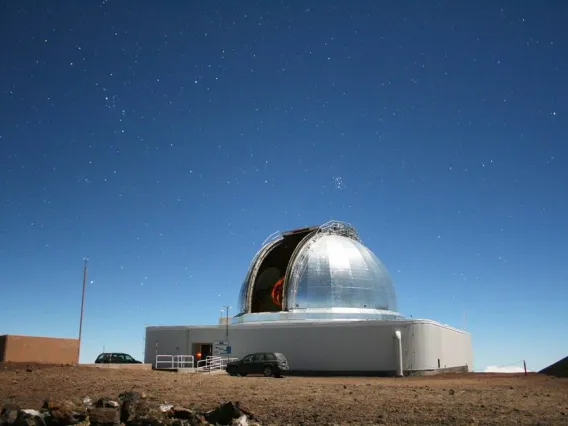
New Data Confirm 2020 SO to be the Upper Centaur Rocket Booster from the 1960’s
Using data collected at NASA’s Infrared Telescope Facility (IRTF) and orbit analysis from the Center for Near-Earth Object Studies (CNEOS) at NASA’s Jet Propulsion Laboratory, scientists have confirmed that Near-Earth Object (NEO) 2020 SO is, in fact, a 1960’s-Era Centaur rocket booster.
New Data Confirm 2020 SO to be the Upper Centaur Rocket Booster from the 1960’s
×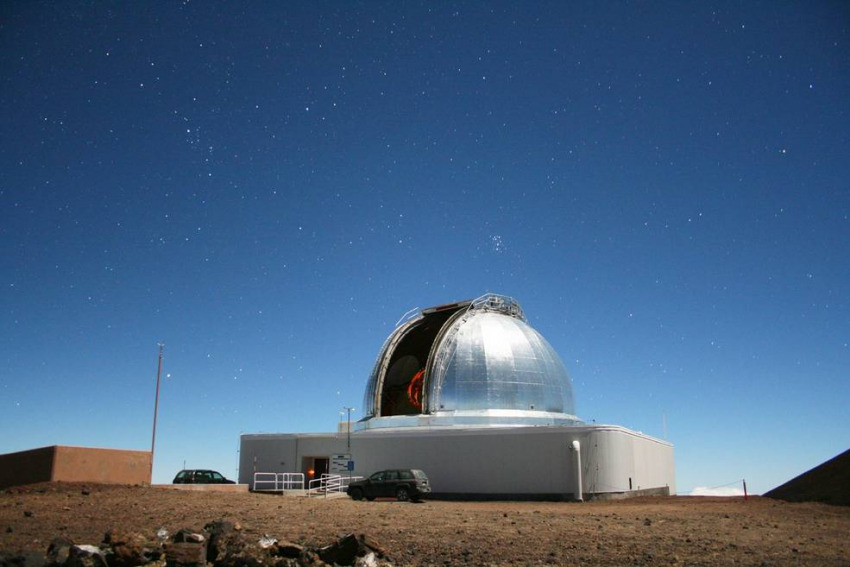
NASA - December 2, 2020
The object, discovered in September by astronomers searching for near-Earth asteroids from the NASA-funded Pan-STARRS1 survey telescope on Maui, garnered interest in the planetary science community due to its size and unusual orbit and was studied by observatories around the world.
Further analysis of 2020 SO’s orbit revealed the object had come close to Earth a few times over the decades, with one approach in 1966 bringing it close enough to suggest it may have originated from Earth. Comparing this data with the history of previous NASA missions, Paul Chodas, CNEOS director, concluded 2020 SO could be the Centaur upper stage rocket booster from NASA’s ill-fated 1966 Surveyor 2 mission to the Moon.
Equipped with this knowledge, a team led by Vishnu Reddy, an associate professor and planetary scientist at the Lunar and Planetary Laboratory at the University of Arizona, performed follow up spectroscopy observations of 2020 SO using NASA’s IRTF on Maunakea, Hawai’i.
“Due to extreme faintness of this object following CNEOS prediction it was a challenging object to characterize” said Reddy. “We got color observations with the Large Binocular Telescope or LBT that suggested 2020 SO was not an asteroid.”
Through a series of follow up observations, Reddy and his team analyzed 2020 SO’s composition using NASA’s IRTF and compared the spectrum data from 2020 SO with that of 301 stainless steel, the material Centaur rocket boosters were made of in the 1960’s. While not immediately a perfect match, Reddy and his team persisted, realizing the discrepancy in spectrum data could be a result of analyzing fresh steel in a lab against steel that would have been exposed to the harsh conditions of space weather for 54 years. This led Reddy and his team to do some additional investigation.
“We knew that if we wanted to compare apples to apples, we’d need to try to get spectral data from another Centaur rocket booster that had been in Earth orbit for many years to then see if it better matched 2020 SO’s spectrum,” said Reddy. “Because of the extreme speed at which Earth-orbiting Centaur boosters travel across the sky, we knew it would be extremely difficult to lock on with the IRTF long enough to get a solid and reliable data set.”
However, on the morning of Dec. 1, Reddy and his team pulled off what they thought would be impossible. They observed another Centaur D rocket booster from 1971 launch of a communication satellite that was in Geostationary Transfer Orbit, long enough to get a good spectrum. With this new data, Reddy and his team were able to compare it against 2020 SO and found the spectra to be consistent with each another, thus definitively concluding 2020 SO to also be a Centaur rocket booster.
“This conclusion was the result of a tremendous team effort,” said Reddy. “We were finally able to solve this mystery because of the great work of Pan-STARRS, Paul Chodas and the team at CNEOS, LBT, IRTF, and the observations around the world.”
2020 SO made its closest approach to Earth on Dec. 1, 2020 and will remain within Earth’s sphere of gravitational dominance—a region in space called the “Hill Sphere” that extends roughly 930,000 miles (1.5 million kilometers) from our planet—until it escapes back into a new orbit around the Sun in March 2021. As NASA-funded telescopes survey the skies for asteroids that could pose an impact threat to Earth, the ability to distinguish between natural and artificial objects is valuable as nations continue to explore and more artificial objects find themselves in orbit about the Sun. Astronomers will continue to observe this particular relic from the early Space Age until it’s gone.
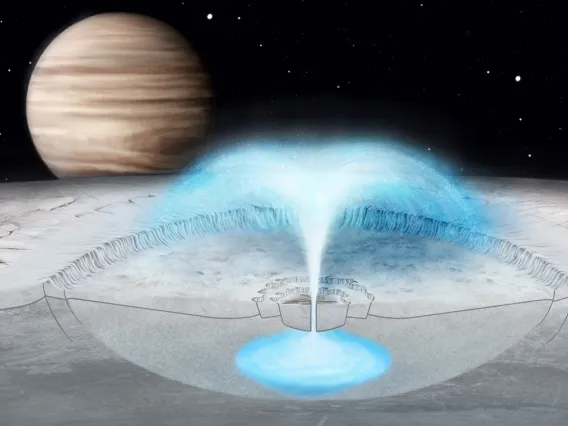
Plumes on Icy Worlds Hold Clues About What Lies Beneath
A new model shows how brine on Jupiter’s moon Europa can migrate within the icy shell to form pockets of salty water that erupt to the surface when freezing. The findings are important for the upcoming Europa Clipper mission and may explain cryovolcanic eruptions across icy bodies in the solar system.
Plumes on Icy Worlds Hold Clues About What Lies Beneath
×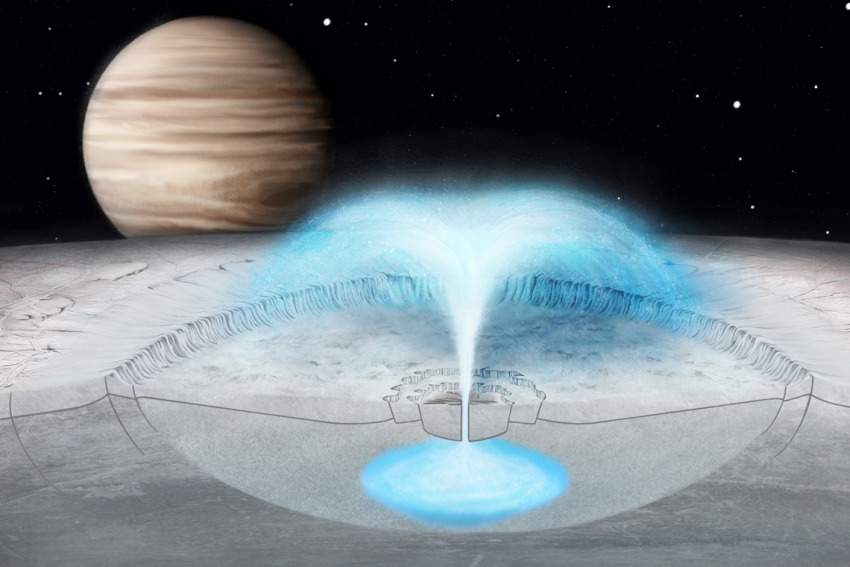
By Stanford University and University Communications - December 16, 2020
On Jupiter's icy moon Europa, powerful eruptions may spew into space, raising questions among hopeful astrobiologists on Earth: What would blast out from miles-high plumes? Could they contain signs of extraterrestrial life? And where in Europa would they originate? A new explanation points to a source closer to the frozen surface than might be expected.
Rather than originating from deep within Europa's oceans, some eruptions may originate from water pockets embedded in the icy shell itself, according to new evidence from researchers at the University of Arizona, Stanford University, the University of Texas and NASA's Jet Propulsion Laboratory.
Using images collected by the NASA spacecraft Galileo, the researchers developed a model to explain how a combination of freezing and pressurization could lead to a cryovolcanic eruption, or a burst of water. The results, published in Geophysical Research Letters, have implications for the habitability of Europa's underlying ocean – and may explain eruptions on other icy bodies in the solar system.
"Plumes are great sources to get information from the interior and subsurface of a planetary body that is otherwise very hard to access far away from our home planet," said Joana Voigt, co-lead author of the paper and a graduate research assistant in Christopher Hamilton's research group at the UArizona Lunar and Planetary Laboratory. "However, we need to better understand the mechanisms driving eruptions and where the plumes were fed from. In the case of Europa there are two possible plumbing systems: transported liquids directly from the ocean below or feeding from a reservoir closer to the surface."
Harbingers of Life?
Scientists have speculated that the vast ocean hidden beneath Europa's icy crust could contain elements necessary to support life. But short of sending a submersible to the moon to explore, it's difficult to know for sure. That's one reason Europa's plumes have garnered so much interest: If the eruptions are coming from the subsurface ocean, the elements could be more easily detected by a spacecraft like the one planned for NASA's upcoming Europa Clipper mission.
But if the plumes originate in the moon's icy shell, they may be less hospitable to life, because it is more difficult to sustain the chemical energy to power life there. In this case, the chances of detecting habitability from space are diminished.
"Understanding where these water plumes are coming from is very important for knowing whether future Europa explorers could have a chance to actually detect life from space without probing Europa's ocean," said the other co-lead author Gregor Steinbrügge, a postdoctoral researcher at Stanford's School of Earth, Energy & Environmental Sciences.
The researchers focused their analyses on Manannán, an 18-mile-wide crater on Europa that was created by an impact with another celestial object some tens of millions of years ago. Reasoning that such a collision would have generated a tremendous amount of heat, they modeled how melting and subsequent freezing of a water pocket within the icy shell could have caused the water to erupt.
The model indicates that as Europa's water transformed into ice during the later stages of the impact, pockets of water with increased salinity could be created in the moon's crust. Furthermore, these salty water pockets can migrate sideways through Europa's ice shell by melting adjacent regions of less brackish ice, and consequently become even saltier in the process.
"We developed a way that a water pocket can move laterally – and that's very important," Steinbrügge said. "It can move along thermal gradients, from cold to warm, and not only in the down direction as pulled by gravity."
A Salty Driver
The model predicts that when migrating brine pockets reached the center of Manannán crater, they became stuck and began freezing, generating pressure that eventually resulted in a plume, estimated to have been over a mile high. The eruption of this plume left a distinguishing mark: a spider-shaped feature on Europa's surface that was observed by Galileo imaging and incorporated in the researchers' model.
Voigt said the spider feature looked immediately familiar, as it reminded her of similar features she had studied in images taken by the UArizona-led HiRISE camera on Mars, but she was skeptical because the geologic settings of Mars and Europa are drastically different.
"But geology doesn't lie," she said. "The features we observe on the surface are a result of the underlying processes, even if our current theories and ideas can't provide an answer – that only means we might need to think outside the box."
The relatively small size of the plume that would form at Manannán indicates that impact craters probably can't explain the source of other, larger plumes on Europa that have been hypothesized based on Hubble and Galileo data, the researchers say. But the process modeled for the Manannán eruption could happen on other icy bodies, even without an impact event.
"We are not suggesting that recently observed plumes on Europa were caused by the same impact triggering mechanism as the older deposits, but brine migration may be a factor," said UArizona's Hamilton, an associate professor of planetary sciences who co-authored the report. He added that the mechanism described in the paper is also applicable to other icy worlds, such as Jupiter's moon Ganymede, Saturn's moons Enceladus and Titan, and the dwarf planet Ceres, which is the largest object in the asteroid belt between Mars and Jupiter.
The study also provides estimates of how salty Europa's frozen surface and ocean may be, which in turn could affect the transparency of its ice shell to radar waves. The calculations, based on imaging from Galileo from 1995 to 1997, show Europa's ocean may be about one-fifth as salty as Earth's ocean – a factor that will improve the capacity for the Europa Clipper mission's radar sounder to collect data from its interior.
The new model offers insights that help untangle Europa's complex surface features, which are subject to hydrological processes, the pull of Jupiter's gravity and hidden tectonic forces within the icy moon.
"Even though plumes generated by brine pocket migration would not provide direct insight into Europa's ocean, our findings are exciting because they suggest that Europa's ice shell itself is very dynamic," Voigt said.
The other co-authors on the paper are Don Blankenship, Krista Soderlund, Natalie Wolfenbarger and Duncan Young from the University of Texas at Austin; Dustin Schroeder at the Stanford's School of Earth, Energy & Environmental Sciences and Steven Vance from NASA's Jet Propulsion Laboratory.
The research was supported by the G. Unger Vetlesen Foundation. A portion of the work was carried out by the Jet Propulsion Laboratory, Caltech, under a contract with NASA.
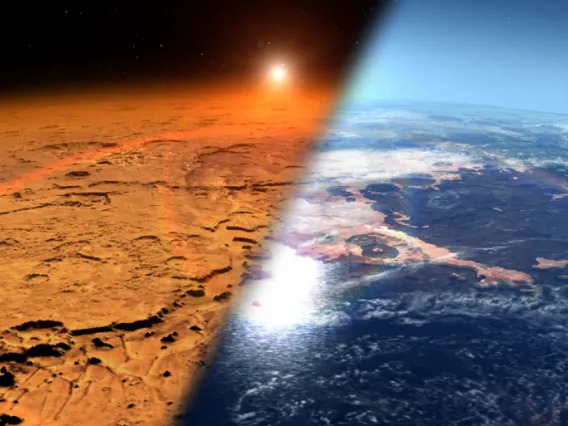
Escape from Mars: How Water Fled the Red Planet
New LPL-led research updates our understanding of how water escaped Mars – not like a leaky faucet but with a sudden splash.
Escape from Mars: How Water Fled the Red Planet
×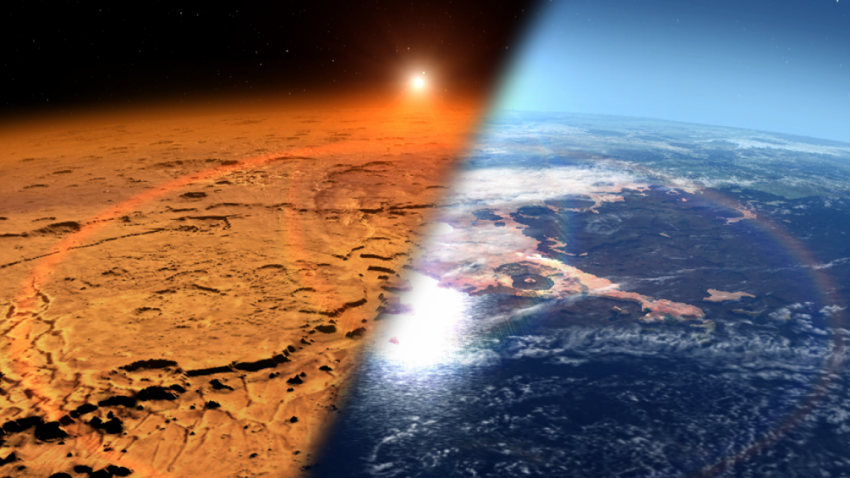
By Mikayla Mace, University Communications - November 12, 2020
Mars once had oceans but is now bone-dry, leaving many to wonder how the water was lost. University of Arizona researchers have discovered a surprisingly large amount of water in the upper atmosphere of Mars, where it is rapidly destroyed, explaining part of this Martian mystery.
Shane Stone, a graduate student in the UArizona Lunar and Planetary Laboratory and lead author of a new paper to be published in Science, describes himself as a planetary chemist. Once a laboratory chemist who helped to develop polymers that could be used to wrap and deliver therapeutic drugs more efficiently, he now studies the chemistry of planetary atmospheres.
Since 2014, he has worked on NASA's MAVEN mission, short for Mars Atmosphere and Volatile Evolution. The MAVEN spacecraft began orbiting Mars in 2014 and has been recording the composition of the upper atmosphere of Earth's planetary neighbor ever since.
"We know that billions of years ago, there was liquid water on the surface of Mars," Stone said. "There must have been a thicker atmosphere, so we know that Mars somehow lost the majority of its atmosphere to space. MAVEN is trying to characterize the processes responsible for this loss, and one portion of that is understanding exactly how Mars lost its water."
Co-authors of the study include Roger Yelle, a UArizona planetary sciences professor and Stone's research adviser, as well as researchers from NASA Goddard Space Flight Center and the Center for Research and Exploration in Space Science and Technology in Maryland.
Watching for Water
As MAVEN orbits Mars, it dips into the planet's atmosphere every 4 1/2 hours. The onboard NGIMS instrument – short for Neutral Gas and Ion Mass Spectrometer – has been measuring the abundance of charged water molecules called ions in the upper Martian atmosphere, about 100 miles from the planet's surface. From this information, scientists can infer how much water is present in the atmosphere.
Past observations using MAVEN and the Hubble Space Telescope showed that loss of water from the Martian upper atmosphere varies with the seasons. Compared to Earth, Mars takes a more oval-shaped path around the sun and is closest to it during summer in the Martian southern hemisphere.
Stone and his team found that when Mars is nearest the sun, the planet warms, and more water – found on the surface in the form of ice – moves from the surface to the upper atmosphere where it is lost to space. This happens once every Martian year or about every two Earth years. The regional dust storms that occur on Mars every Martian year and the global dust storms that occur across the planet about once every 10 years lead to further heating of the atmosphere and a surge in the upward movement of water.
The processes that make this cyclical movement possible contradict the classical picture of water escape from Mars, showing it is incomplete, Stone said. According to the classical process, ice formed from water is converted to a gas and is destroyed by the sun's rays in the lower atmosphere. This process, however, would play out as a slow, steady trickle, unaffected by the seasons or dust storms, which doesn't mesh with current observations.
"This is important because we didn't expect to see any water in the upper atmosphere of Mars at all," Stone said. "If we compare Mars to Earth, water on Earth is confined close to the surface because of something called the hygropause. It's just a layer in the atmosphere that's cold enough to condense (and therefore stop) any water vapor traveling upward."
The team argues that water is moving past what should be Mars' hygropause, which is likely too warm to stop the water vapor. Once in the upper atmosphere, water molecules are broken apart by ions very quickly – within four hours, they calculate – and the byproducts are then lost to space.
"The loss of its atmosphere and water to space is a major reason Mars is cold and dry compared to warm and wet Earth. This new data from MAVEN reveals one process by which this loss is still occurring today," Stone said.
A Dry and Dusty World
When the team extrapolated their findings back 1 billion years, they found that this process can account for the loss of a global ocean about 17 inches deep.
"If we took water and spread it evenly over the entire surface of Mars, that ocean of water lost to space due to the new process we describe would be over 17 inches deep," Stone said. "An additional 6.7 inches would be lost due solely to the effects of global dust storms."
During global dust storms, 20 times more water can be transported to the upper atmosphere. For example, one global dust storm lasting 45 days releases the same amount of water to space as Mars would lose during a calm Martian year, or 687 Earth days.
And while Stone and his team can't extrapolate farther back than 1 billion years, he thinks that this process likely didn't work the same before that, because Mars might have had a stronger hygropause long ago.
"Before the process we describe began to operate, there must have been a significant amount of atmospheric escape to space already," Stone said. "We still need to nail down the impact of this process and when it began to operate."
In the future, Stone would like to study the atmosphere of Saturn's moon Titan.
"Titan has an interesting atmosphere in which organic chemistry plays a significant role," Stone said. "As a former synthetic organic chemist, I'm eager to investigate these processes."

Life on Ancient Earth and Alien Planets: UArizona to Lead NASA Astrobiology Projects
Two of the eight interdisciplinary research teams selected by the NASA Astrobiology Program to inaugurate its Interdisciplinary Consortia for Interdisciplinary Research program are located at the University of Arizona. Led by Betül Kaçar and Dániel Apai, the teams were selected from a pool of more than 40 proposals.
Life on Ancient Earth and Alien Planets: UArizona to Lead NASA Astrobiology Projects
×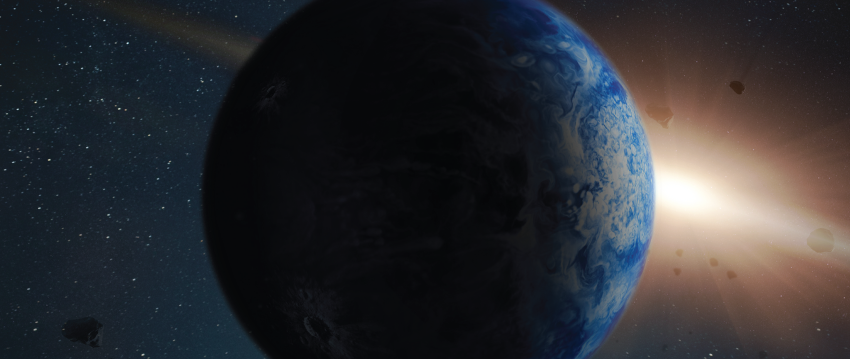
By Daniel Stolte, University Communications - November 9, 2020
The NASA Astrobiology Program has selected eight new interdisciplinary research teams to inaugurate its Interdisciplinary Consortia for Astrobiology Research program, including two teams at the University of Arizona. Led by Betül Kaçar and Dániel Apai, the teams were selected from a pool of more than 40 proposals. The breadth and depth of the research of these teams spans the spectrum of astrobiology research, from cosmic origins to planetary system formation, origins and evolution of life, and the search for life beyond Earth.
The two ICAR grants total approximately $12 million.
"Being part of this inaugural effort will position the University of Arizona in a leading role at the forefront of the most pressing and challenging questions in astrobiology," said University of Arizona President Robert C. Robbins. "It is an incredible honor to have two teams from the university selected for this important work and I look forward to following their progress in this groundbreaking research."
Astrobiology is a discipline devoted to the study of the origins, evolution and distribution of life in the universe, the declared goal of NASA's Astrobiology Program. The program is central to NASA's continued exploration of the solar system and beyond, and supports research into the origin and early evolution of life, the potential of life to adapt to different environments, and the implications for life elsewhere.
Kaçar's ICAR project team is named Metal Utilization and Selection Across Eons, or MUSE, and will explore "What Life Wants: Exploring the Natural Selection of Elements," which focuses on a question fundamental to the field of astrobiology as a whole, she said.
"What are the essential attributes of life, and how should they shape our notions of habitability and the search for life on other worlds?" Kaçar said. Motivated by this broad question, her project team will explore the natural selection of the chemical elements during the coevolution of life and environment on Earth.
"We will connect earth sciences with astronomy and biology, using tools drawn from synthetic biology, genomics and evolution, as well as geochemistry and biochemistry, to pioneer an entirely new scientific discipline – 'evolutionary metallomics' – studying the evolution of metal use in biological pathways, particularly the biological nitrogen cycle."
Kaçar's research program will cultivate a new cohort of scientists with experimental and analytical expertise who can combine earth and life science disciplines to inform astrobiology search strategies. Being able to tease apart the essential attributes of life would have a direct impact on scientists' ideas of habitability and the search for life on other worlds.
"While we have learned a tremendous amount about how nature uses these elements in the biochemistry of organisms, there remains deep uncertainty about why evolution selected for these elements," she said. "In other words, what does life want, and why does it want what it wants?"
Kaçar's team will approach this puzzle by studying life on early Earth. This will involve geochemical and biological investigations that involve ancient materials, experiments and modern natural systems, such as tracking down microbes in extreme environments and remote locations, as well as studying ancient variants of proteins and microbial metabolisms in the lab.
"ICAR will allow us to rewind the evolutionary clock in the laboratory, and explore the evolution of reconstructed ancient proteins, and experimentally study their characteristics," Kaçar said. "We look forward to supporting NASA's Science Mission Directorate on priority astrobiology goals."
The project will bring together earth scientists and life scientists in a unique, problem-focused collaboration closely aligned with NASA's strategies, Kaçar said.
"It is easy to see on Earth today that life depends on certain elements," she said. "We want to study whether this dependence is an inevitable consequence of the elements available to life, or whether it is an accident of history that might have worked out very differently if we replayed the tape of evolution under slightly different conditions – as seems inevitable on other worlds."
Apai is an associate professor in the UArizona departments of astronomy and planetary sciences, and Kaçar is an assistant professor with joint appointments in the departments of molecular and cellular biology and astronomy and planetary sciences. She also is a member of UArizona's BIO5 Institute.
The team led by Apai, "Alien Earths," is poised to transform scientists' understanding of the habitability of nearby planetary systems. Alien Earths will carry out 14 closely coordinated research projects, including theoretical, laboratory analysis and observational studies.
Recent discoveries suggest that habitable planets may be very common, Apai said, which begs the question, "Which nearby planetary systems are likely to host habitable planets and possibly life?" NASA and the astrobiology community are working on ideas for powerful next-generation space telescopes that could scan the atmospheres of nearby planets for gases that indicate the presence of life.
"Earthlike planets remain very difficult to find and, even more so, to characterize," Apai said. "Our team will help assess which nearby planetary systems are more likely to be good targets, an essential step in defining the optimal strategy for our search for life in the universe."
Apai's ICAR grant builds on and extends a major research program led by his group called "Earths in Other Solar Systems," or EOS, a five-year program that led to more than 140 refereed scientific papers and is now in its final year of funding. EOS is dedicated to finding out how habitable planets form, and the new ICAR project will take those insights, complement them with new projects, and apply the combined knowledge to nearby planets to investigate which ones may be suitable for life, Apai said.
"Like EOS, Alien Earths will not only be a fascinating research program," Apai said. "We defined it strategically to closely tie into upcoming and next-generation NASA exoplanet missions, with the goal to inform, guide and enhance the capabilities of future NASA missions that search for life on other worlds."
The NASA ICAR award is critically important to launch the work of the Alien Earths team, a team of more than 50 undergraduate and graduate students, plus junior and senior researchers from seven countries. The team will form a powerful, international, multidisciplinary hub for the exploration of habitable planetary systems.
Both projects will include interdisciplinary collaborations within UArizona, connecting Steward Observatory and the Lunar and Planetary Laboratory, with the departments of molecular and cellular biology, chemistry and biochemistry, computer science, ecology and evolutionary biology, and the BIO5 Institute.
"The University of Arizona has deep, unparalleled expertise and decades-long tradition in space science, and, perhaps now more than ever, we are focused on leading ambitious, imaginative research programs that leverage our unique capabilities while bringing together talented scientists from across the state and nation," said Elizabeth "Betsy" Cantwell, senior vice president for research and innovation. "Drs. Kaçar and Apai's astrobiological research is absolutely demonstrative of that effort."
The Alien Earths team is led by the University of Arizona and includes the following partner institutions: Arizona State University; the Massachusetts Institute of Technology; NSF O/IR Lab; the University of Chicago; Adolfo Ibáñez University; Bern University; Lund University; Paris Observatory; the University of Exeter; and Xiamen University.
Kaçar's project is a first of its kind and includes the following partner institutions:
Arizona State University; Stanford University; Utah State University; the University of Minnesota; the University of Tennessee, Knoxville; Iowa State University; and the University of Alberta.
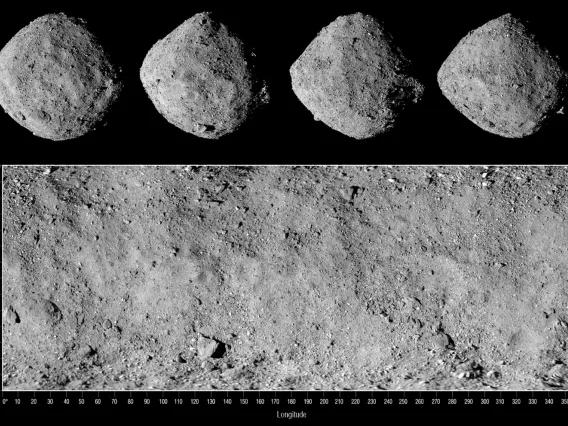
Asteroid's Scars Tell Stories of its Past
Impact craters left by space debris in the boulders on asteroid Bennu's rugged surface allowed researchers to reconstruct the history of the near-Earth object in unprecedented detail.
Asteroid's Scars Tell Stories of its Past
×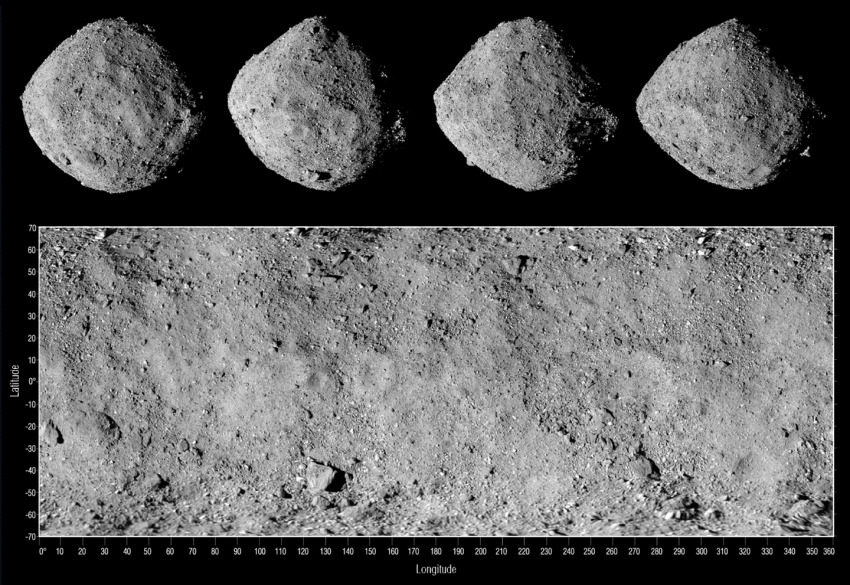
By Daniel Stolte, University Communications - October 30, 2020
By studying impact marks on the surface of asteroid Bennu – the target of NASA's OSIRIS-REx mission – a team of researchers led by the University of Arizona has uncovered the asteroid's past and revealed that despite forming hundreds of millions of years ago, Bennu wandered into Earth's neighborhood only very recently.
The study, published in the journal Nature, provides a new benchmark for understanding the evolution of asteroids, offers insights into a poorly understood population of space debris hazardous to spacecraft, and enhances scientists' understanding of the solar system.
The researchers used images and laser-based measurements taken during a two-year surveying phase in which the OSIRIS-REx spacecraft, about the size of a 15-passenger van, orbited Bennu and broke the record for the smallest spacecraft to orbit a small body.
Presented at the opening day of the American Astronomical Society's Division of Planetary Science meeting on Oct. 26, the paper details the first observations and measurements of impact craters on individual boulders on an airless planetary surface since the Apollo missions to the moon 50 years ago, according to the authors.
The publication comes just a few days after a major milestone for NASA's University of Arizona-led OSIRIS-REx mission. On Oct. 20, the spacecraft successfully descended to asteroid Bennu to grab a sample from its boulder-scattered surface – a first for NASA. The sample has now been successfully stowed and will be returned to Earth for study in 2023, where it could give scientists insight into the earliest stages of the formation of our solar system.
Impact Craters on Rocks Tell a Story
Although Earth is being pelted with more than 100 tons of space debris each day, it is virtually impossible to find a rockface pitted by impacts from small objects at high velocities. Courtesy of our atmosphere, we get to enjoy any object smaller than a few meters as a shooting star rather than having to fear being struck by what essentially amounts to a bullet from outer space.
Planetary bodies lacking such a protective layer, however, bear the full brunt of a perpetual cosmic barrage, and they have the scars to show for it. High-resolution images taken by the OSIRIS-REx spacecraft during its two-year survey campaign allowed researchers to study even tiny craters, with diameters ranging from a centimeter to a meter, on Bennu's boulders.
The team found boulders of 1 meter or larger to be scarred, on average, by anywhere from one to 60 pits – impacted by space debris ranging in size from a few millimeters to tens of centimeters.
"I was surprised to see these features on the surface of Bennu," said the paper's lead author, Ronald Ballouz, a postdoctoral researcher in the UArizona Lunar and Planetary Laboratory and a scientist with the OSIRIS-REx regolith development working group. "The rocks tell their history through the craters they accumulated over time. We haven't observed anything like this since astronauts walked on the moon."
For Ballouz, who grew up during the 1990s in post-civil war Beirut, Lebanon, the image of a rock surface pitted with small impact craters evoked childhood memories of building walls riddled with bullet holes in his war-torn home country.
"Where I grew up, the buildings have bullet holes all over, and I never thought about it," he said. "It was just a fact of life. So, when I looked at the images from the asteroid, I was very curious, and I immediately thought these must be impact features."
The observations made by Ballouz and his team bridge a gap between previous studies of space debris larger than a few centimeters, based on impacts on the moon, and studies of objects smaller than a few millimeters, based on observations of meteors entering Earth's atmosphere and impacts on spacecraft.
"The objects that formed the craters on Bennu's boulders fall within this gap that we don't really know much about," Ballouz said, adding that rocks in that size range are an important field of study, mainly because they represent hazards for spacecraft in orbit around Earth. "An impact from one of these millimeter to centimeter-size objects at speeds of 45,000 miles per hour can be dangerous."
This composite image of a boulder on Bennu’s surface shows the cascading rim of one of the asteroid’s ancient craters that originated while Bennu resided in the asteroid belt. The image combines photos from OSIRIS-REx and reconstructed shape models built from the OSIRIS-REx laser altimeter instrument. The overlaid colors highlight the topography of the boulder (warmer colors are higher elevation).University of Arizona/Johns Hopkins APL/York University
Ballouz and his team developed a technique to quantify the strength of solid objects using remote observations of craters on the surfaces of boulders – a mathematical formula that allows researchers to calculate the maximum impact energy that a boulder of a given size and strength could endure before being smashed. In other words, the crater distribution found on Bennu today keeps a historical record of the frequency, size and velocity of impact events the asteroid has experienced throughout its history.
"The idea is actually pretty simple," Ballouz said, using a building exposed to artillery fire as an analogy to boulders on an asteroid. "We ask, 'What is the largest crater you can make on that wall before the wall disintegrates?' Based on observations of multiple walls of the same size, but with different sized craters, you can get some idea of the strength of that wall."
The same holds true for a boulder on an asteroid or other airless body, said Ballouz, who added that the approach could be used on any other asteroid or airless body that astronauts or spacecraft may visit in the future.
"If a boulder gets hit by something larger than an object that would leave a certain size cater, it would just disappear," he explained. In other words, the size distribution of boulders that have persisted on Bennu serve as silent witnesses to its geologic past.
A Newcomer to Earth's Neighborhood
Applying the technique to boulders ranging in size from pebbles to parking garages, the researchers were able to make inferences about the sizes and type of impactors to which the boulders were exposed, and for how long.
The authors conclude that the largest craters on Bennu's boulders were created while Bennu resided in the asteroid belt, where impact speeds are lower than in the near-Earth environment, but are more frequent and often near the limit of what the boulders could withstand. Smaller craters, on the other hand, were acquired more recently, during Bennu's time in near-Earth space, where impact speeds are higher but potentially disruptive impactors are much less common.
Based on these calculations, the authors determine that Bennu is a relative newcomer to Earth's neighborhood. Although it is thought to have formed in the main asteroid belt more than 100 million years ago, it is estimated that it was kicked out of the asteroid belt and migrated to its current territory only 1.75 million years ago. Extending the results to other near-Earth objects, or NEOs, the researchers also suggest that these objects likely come from parent bodies that fall in the category of asteroids, which are mostly rocky with little or no ice, rather than comets, which have more ice than rock.
While theoretical models suggest that the asteroid belt is the reservoir for NEOs, no observational evidence of their provenance was available other than meteorites that fell to Earth and were collected, Ballouz said. With these data, researchers can validate their models of where NEOs come from, according to Ballouz, and get an idea of how strong and solid these objects are – crucial information for any potential missions targeting asteroids in the future for research, resource extraction or protecting Earth from impact.
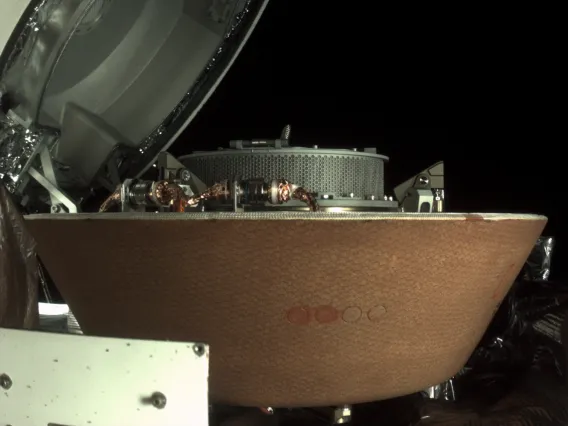
OSIRIS-REx Successfully Stows Sample of Asteroid Bennu
The mission team spent two days working around the clock to carry out the stowage procedure.
OSIRIS-REx Successfully Stows Sample of Asteroid Bennu
×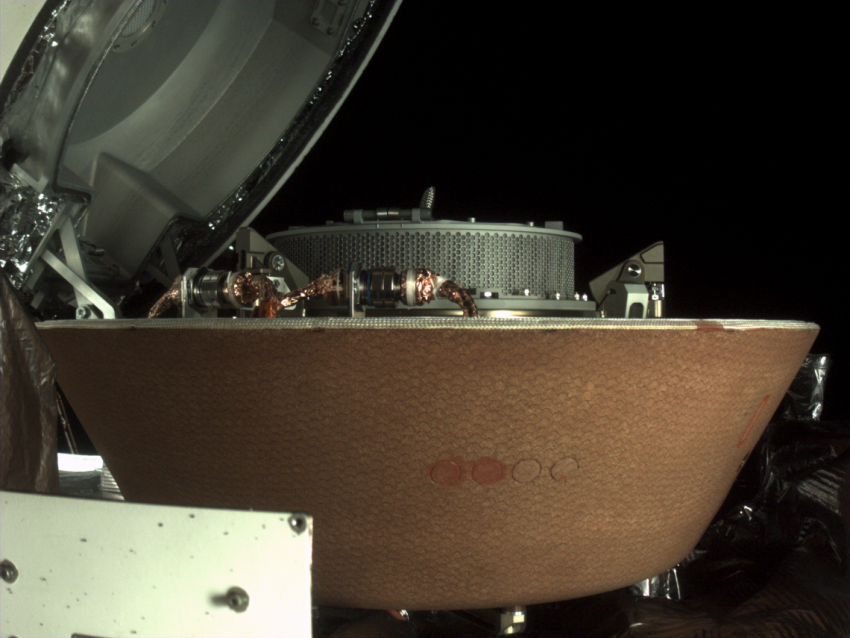
NASA Goddard Spaceflight Center - October 29, 2020
NASA's University of Arizona-led OSIRIS-REx mission has successfully stowed the spacecraft's Sample Return Capsule and its abundant sample of asteroid Bennu. On Oct. 28, the mission team sent commands to the spacecraft, instructing it to close the capsule – marking the end of one of the most challenging phases of the mission.
"I'm very thankful that our team worked so hard to get this sample stowed as quickly as they did,” said Dante Lauretta, OSIRIS-REx principal investigator and a professor of lunar and planetary sciences at the University of Arizona. "Now, we can look forward to receiving the sample here on Earth and opening up that capsule."
"This achievement by OSIRIS-REx on behalf of NASA and the world has lifted our vision to the higher things we can achieve together, as teams and nations," said NASA Administrator Jim Bridenstine. "Together, a team comprising industry, academia and international partners, and a talented and diverse team of NASA employees with all types of expertise, has put us on course to vastly increase our collection on Earth of samples from space. Samples like this are going to transform what we know about our universe and ourselves, which is at the base of all NASA's endeavors."
The OSIRIS-REx mission team celebrates as they receive confirmation that the spacecraft’s sample return capsule was successfully closed. The stow sequence was successfully completed on Oct. 28 from the Mission Support Area at Lockheed Martin Space in Littleton, Colorado.Lockheed Martin
The mission team spent two days working around the clock to carry out the stowage procedure, with preparations for the stowage event beginning Oct. 24. The process to stow the sample is unique compared to other spacecraft operations and required the team's continuous oversight and input over the two-day period. For the spacecraft to proceed with each step in the stowage sequence, the team had to assess images and telemetry from the previous step to confirm the operation was successful and the spacecraft was ready to continue. Given that OSIRIS-REx is currently more than 205 million miles from Earth, this required the team to also work with a greater than 18.5-minute time delay for signals traveling in each direction.
Throughout the process, the OSIRIS-REx team continually assessed the Touch-And-Go Sample Acquisition Mechanism's wrist alignment to ensure the collector head was being placed properly into the Sample Return Capsule. Additionally, the team inspected images to observe any material escaping from the collector head to confirm that no particles would hinder the stowage process. StowCam images of the stowage sequence show that a few particles escaped during the stowage procedure, but the team is confident that a plentiful amount of material remains inside of the head.
"Given the complexity of the process to place the sample collector head onto the capture ring, we expected that it would take a few attempts to get it in the perfect position," said Rich Burns, OSIRIS-REx project manager at NASA's Goddard Space Flight Center in Greenbelt, Maryland. "Fortunately, the head was captured on the first try, which allowed us to expeditiously execute the stow procedure."
By the evening of Oct. 27, the spacecraft's Touch-And-Go Sample Acquisition Mechanism, or TAGSAM, arm had placed the collector head into the Sample Return Capsule. The following morning, the OSIRIS-REx team verified that the collector head was thoroughly fastened into the capsule by performing a "backout check." This sequence commanded the TAGSAM arm to attempt to back out of the capsule – which tugged on the collector head and ensured the latches are well secured.
"I want to thank the OSIRIS-REx team from the University of Arizona, NASA Goddard, Lockheed Martin, and their partners, and also especially the SCaN and Deep Space Network people at NASA and JPL, who worked tirelessly to get us the bandwidth we needed to achieve this milestone, early and while still hundreds of millions of miles away," said Thomas Zurbuchen, NASA's associate administrator for science at the agency's headquarters in Washington, D.C. "What we have done is a real first for NASA, and we will benefit for decades by what we have been able to achieve at Bennu."
On the afternoon of Oct. 28, following the backout check, the mission team sent commands to disconnect the two mechanical parts on the TAGSAM arm that connect the sampler head to the arm. The spacecraft first cut the tube that carried the nitrogen gas that stirred up the sample through the TAGSAM head during sample collection, and then separated the collector head from the TAGSAM arm itself.
That evening, the spacecraft completed the final step of the sample stowage process –closing the Sample Return Capsule. To secure the capsule, the spacecraft closed the lid and then fastened two internal latches. As of late Oct. 28, the sample of Bennu is safely stored and ready for its journey to Earth.
The stowage process, originally scheduled to begin in early November, was expedited after sample collection when the mission team received images that showed the spacecraft's collector head overflowing with material. The images indicated that the spacecraft collected well over 2 ounces, or 60 grams, of Bennu's surface material, and that some of these particles appeared to be slowly escaping from the head. A mylar flap designed to keep the sample inside the head appeared to be wedged open by some larger rocks. Now that the head is secure inside the Sample Return Capsule, pieces of the sample will no longer be lost.
The OSIRIS-REx team will now focus on preparing the spacecraft for the next phase of the mission – Earth Return Cruise. The departure window opens in March 2021 for OSIRIS-REx to begin its voyage home, and the spacecraft is targeting delivery of the Sample Return Capsule to Earth on Sep. 24, 2023.
Goddard provides overall mission management, systems engineering and the safety and mission assurance for OSIRIS-REx. Lauretta of the University of Arizona is the principal investigator, and the University of Arizona also leads the science team and the mission's science observation planning and data processing. Lockheed Martin Space in Littleton, Colorado, built the spacecraft and provides flight operations. Goddard and KinetX Aerospace are responsible for navigating the OSIRIS-REx spacecraft. OSIRIS-REx is the third mission in NASA's New Frontiers Program, which is managed by NASA's Marshall Space Flight Center in Huntsville, Alabama, for the agency's Science Mission Directorate in Washington.
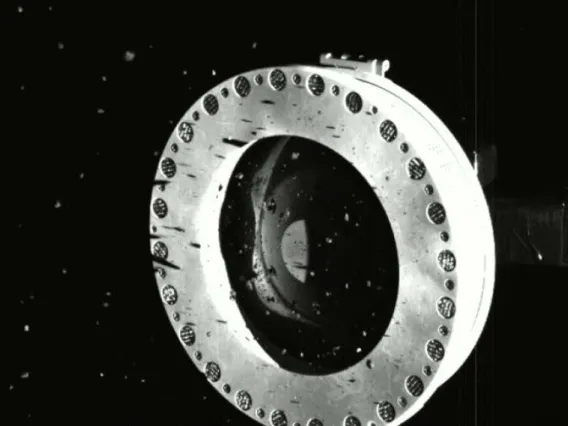
OSIRIS-REx Spacecraft Collects Significant Amount of Asteroid
The spacecraft seems to have bit off more than it can chew, so the mission team will expedite stowing the sample for the return trip home.
OSIRIS-REx Spacecraft Collects Significant Amount of Asteroid
×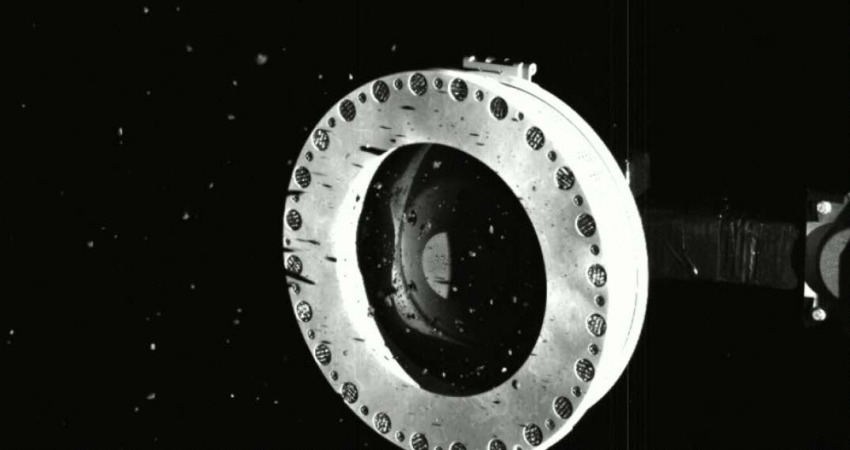
NASA and Goddard Space Flight Center - October 23, 2020
Two days after touching down on asteroid Bennu, NASA's University of Arizona-led OSIRIS-REx mission team received images confirming that the spacecraft has collected more than enough material to meet one of its main mission requirements – acquiring at least 2 ounces, or 60 grams, of the asteroid's surface material.
The spacecraft captured images of the sample collector head as it moved through several different positions. In reviewing these images, the OSIRIS-REx team noticed both that the head appeared to be full of asteroid particles, and that some of these particles appeared to be escaping slowly from the sample collector, called the Touch-And-Go Sample Acquisition Mechanism, or TAGSAM, head. They suspect bits of material are passing through small gaps where a mylar flap – the collector's lid – is slightly wedged open by larger rocks.
"It's been another set of surprising days on the OSIRIS-REx mission," said principal investigator Dante Lauretta, a UArizona professor in the Lunar and Planetary Laboratory. "This is the mission that keeps on surprising us."
Lauretta leads the science team and the mission's science observation planning and data processing.
The original plan was to weigh the sample by spinning the spacecraft in the coming weeks, but images of the sample head indicate that more than enough sample was collected on Wednesday's Touch-And-Go, or TAG sample collection maneuver.
"Although we may have to move more quickly to stow the sample, it's not a bad problem to have. We are so excited to see what appears to be an abundant sample that will inspire science for decades beyond this historic moment," said Thomas Zurbuchen, NASA's associate administrator for science at the agency's headquarters in Washington, D.C.
The team believes it has collected a sufficient sample and is on a path to stow the sample as quickly as possible. The team came to this conclusion after comparing images of the empty collector head with Oct. 22 images of the TAGSAM head after the sample collection event on Oct. 21.
The images also show that any spacecraft or TAGSAM instrument movement may lead to further sample loss. To preserve the remaining material, the mission team decided to forgo the sample mass measurement activity originally scheduled for Oct. 24, and canceled a braking burn scheduled for Friday.
From here, the OSIRIS-REx team will focus on stowing the sample in the sample return capsule, where any loose material will be kept safe during the spacecraft's journey back to Earth.
"We are working to keep up with our own success here, and my job is to safely return as large a sample of Bennu as possible," Lauretta said. "The loss of mass is of concern to me, so I'm strongly encouraging the team to stow this precious sample as quickly as possible."
The TAGSAM head performed the sampling event in optimal conditions. Newly available analyses show that the collector head was flush with Bennu's surface when it made contact and when the nitrogen gas bottle was fired to stir surface material. It also penetrated several centimeters into the asteroid's surface material. All data so far suggest that the collector head is holding much more than 2 ounces of Bennu surface material.
The OSIRIS-REx spacecraft remains in good condition, and the mission team is finalizing a timeline for sample storage. An update will be provided once a decision is made on the sample storage timing and procedures.
OSIRIS-REx launched in Sept. 2016 and will return to Earth in 2023.
NASA's Goddard Space Flight Center in Greenbelt, Maryland, provides overall mission management, systems engineering and the safety and mission assurance for OSIRIS-REx. Lockheed Martin Space in Denver built the spacecraft and is providing flight operations. Goddard and KinetX Aerospace of Tempe, Arizona, are responsible for navigating the OSIRIS-REx spacecraft. OSIRIS-REx is the third mission in NASA's New Frontiers Program, which is managed by NASA's Marshall Space Flight Center in Huntsville, Alabama, for the agency's Science Mission Directorate in Washington.
